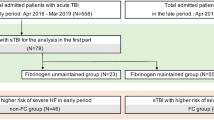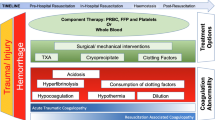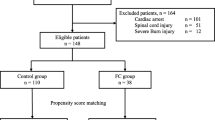Abstract
Background
The association between traumatic brain injury (TBI) and coagulopathy is well established. While coagulopathy prophylaxis in TBI involves replenishing coagulation factors with fresh frozen plasma (FFP), its effectiveness is controversial. We investigated the relationship between plasma fibrinogen concentration 3 h after initiating FFP transfusion and outcomes and evaluated the correlation with D-dimer levels at admission.
Methods
We retrospectively examined data from 380 patients with severe isolated TBI with blood samples collected a maximum of 1 h following injury. Plasma fibrinogen and D-dimer concentrations were obtained at admission, and plasma fibrinogen concentration was again assessed 3–4 h following injury. The patients were divided into two groups based on whether or not they received FFP transfusion. Patients were also divided into subgroups according their fibrinogen level: ≥ 150 mg/dL (high-fibrinogen subgroup) or < 150 mg/dL (low-fibrinogen subgroup) 3 h after injury. Demographic, clinical, radiological and laboratory data were compared between these subgroups.
Results
Glasgow Outcome Scale (GOS) scores at discharge and 3 months after injury were significantly lower in the FFP transfusion group than in the FFP non-transfusion group. Among patients who received FFP, GOS scores at discharge and 3 months after injury were significantly higher in the high-fibrinogen subgroup than in the low-fibrinogen subgroup. Elevated admission D-dimer predicted subsequent fibrinogen decrease.
Conclusions
In FFP transfusion, fibrinogen level ≥ 150 mg/dL 3 h after injury was associated with better outcomes in TBI patients. Assessing the admission D-dimer and tracking the fibrinogen are crucial for optimal coagulopathy prophylaxis in TBI patients.


Similar content being viewed by others
References
Allard CB, Scarpelini S, Rhind SG, Baker AJ, Shek PN, Tien H, Fernando M, Tremblay L, Morrison LJ, Pinto R, Rizoli SB (2009) Abnormal coagulation tests are associated with progression of traumatic intracranial hemorrhage. J Trauma 67:959–967
Anglin CO, Spence JS, Warner MA, Paliotta C, Harper C, Moore C, Sarode R, Madden C, Diaz-Arrastia R (2013) Effects of platelet and plasma transfusion on outcome in traumatic brain injury patients with moderate bleeding diatheses. J Neurosurg 118:676–686
Association for the Advancement of Automotive Medicine (1998) The Abbreviated Injury Scale (AIS) 1998 revision. Des Plaines, Illinois
Chang R, Folkerson LE, Sloan D, Tomasek JS, Kitagawa RS, Choi HA, Wade CE, Holcomb JB (2017) Early plasma transfusion is associated with improved survival after isolated traumatic brain injury in patients with multifocal intracranial hemorrhage. Surgery 161:538–545
Cotton BA, Au BK, Nunez TC, Gunter OL, Robertson AM, Young PP (2009) Predefined massive transfusion protocols are associated with a reduction in organ failure and postinjury complications. J Trauma 66:41–48 discussion 48–49
Epstein DS, Mitra B, O’Reilly G, Rosenfeld JV, Cameron PA (2014) Acute traumatic coagulopathy in the setting of isolated traumatic brain injury: a systematic review and meta-analysis. Injury 45:819–824
Etemadrezaie H, Baharvahdat H, Shariati Z, Lari SM, Shakeri MT, Ganjeifar B (2007) The effect of fresh frozen plasma in severe closed head injury. Clin Neurol Neurosurg 109:166–171
Force ADT, Ranieri VM, Rubenfeld GD, Thompson BT, Ferguson ND, Caldwell E, Fan E, Camporota L, Slutsky AS (2012) Acute respiratory distress syndrome: the Berlin definition. JAMA 307:2526–2533
Fries D, Innerhofer P, Perger P, Gutl M, Heil S, Hofmann N, Kneifel W, Neuner L, Pernerstorfer T, Pfanner G, Schochl H, Ziegler B, Kolblinger C, Kozek-Langenecker S (2010) Coagulation management in trauma-related massive bleeding. Recommendations of the Task Force for Coagulation (AGPG) of the Austrian Society of Anesthesiology, Resuscitation and Intensive Care Medicine (OGARI). Anasthesiol Intensivmed Notfallmed Schmerzther 45:552–561
Gando S (2015) Hemostasis and thrombosis in trauma patients. Semin Thromb Hemost 41:26–34
Gomez PA, Lobato RD, Ortega JM, De La Cruz J (1996) Mild head injury: differences in prognosis among patients with a Glasgow Coma Scale score of 13 to 15 and analysis of factors associated with abnormal CT findings. Br J Neurosurg 10:453–460
Greuters S, van den Berg A, Franschman G, Viersen VA, Beishuizen A, Peerdeman SM, Boer C (2011) Acute and delayed mild coagulopathy are related to outcome in patients with isolated traumatic brain injury. Crit Care 15:R2
Guidelines committee on the management of severe head injury, Japan society of neurotraumatology (2013) Guidelines for the management of severe head injury, 3rd edn. Igaku-Shoin Ltd., Tokyo (Japanese)
Halpern CH, Reilly PM, Turtz AR, Stein SC (2008) Traumatic coagulopathy: the effect of brain injury. J Neurotrauma 25:997–1001
Harhangi BS, Kompanje EJ, Leebeek FW, Maas AI (2008) Coagulation disorders after traumatic brain injury. Acta Neurochir 150:165–175 discussion 175
Hiippala ST, Myllyla GJ, Vahtera EM (1995) Hemostatic factors and replacement of major blood loss with plasma-poor red cell concentrates. Anesth Analg 81:360–365
Hijazi N, Abu Fanne R, Abramovitch R, Yarovoi S, Higazi M, Abdeen S, Basheer M, Maraga E, Cines DB, Higazi AA (2015) Endogenous plasminogen activators mediate progressive intracerebral hemorrhage after traumatic brain injury in mice. Blood 125:2558–2567
Holcomb JB, Jenkins D, Rhee P, Johannigman J, Mahoney P, Mehta S, Cox ED, Gehrke MJ, Beilman GJ, Schreiber M, Flaherty SF, Grathwohl KW, Spinella PC, Perkins JG, Beekley AC, McMullin NR, Park MS, Gonzalez EA, Wade CE, Dubick MA, Schwab CW, Moore FA, Champion HR, Hoyt DB, Hess JR (2007) Damage control resuscitation: directly addressing the early coagulopathy of trauma. J Trauma 62:307–310
Hukkelhoven CW, Steyerberg EW, Rampen AJ, Farace E, Habbema JD, Marshall LF, Murray GD, Maas AI (2003) Patient age and outcome following severe traumatic brain injury: an analysis of 5600 patients. J Neurosurg 99:666–673
Jennett B, Snoek J, Bond MR, Brooks N (1981) Disability after severe head injury: observations on the use of the Glasgow Outcome Scale. J Neurol Neurosurg Psychiatry 44:285–293
Kushimoto S, Shibata Y, Yamamoto Y (2003) Implications of fibrinogenolysis in patients with closed head injury. J Neurotrauma 20:357–363
Laroche M, Kutcher ME, Huang MC, Cohen MJ, Manley GT (2012) Coagulopathy after traumatic brain injury. Neurosurgery 70:1334–1345
Levy JH, Welsby I, Goodnough LT (2014) Fibrinogen as a therapeutic target for bleeding: a review of critical levels and replacement therapy. Transfusion (Paris) 54:1389–1405
Lustenberger T, Talving P, Kobayashi L, Inaba K, Lam L, Plurad D, Demetriades D (2010) Time course of coagulopathy in isolated severe traumatic brain injury. Injury 41:924–928
Maegele M (2013) Coagulopathy after traumatic brain injury: incidence, pathogenesis, and treatment options. Transfusion (Paris) 53(Suppl 1):28S–37S
Maegele M, Schochl H, Menovsky T, Marechal H, Marklund N, Buki A, Stanworth S (2017) Coagulopathy and haemorrhagic progression in traumatic brain injury: advances in mechanisms, diagnosis, and management. Lancet Neurol 16:630–647
Marshall JC, Cook DJ, Christou NV, Bernard GR, Sprung CL, Sibbald WJ (1995) Multiple organ dysfunction score: a reliable descriptor of a complex clinical outcome. Crit Care Med 23:1638–1652
May AK, Young JS, Butler K, Bassam D, Brady W (1997) Coagulopathy in severe closed head injury: is empiric therapy warranted? Am Surg 63:233–236 discussion 236–237
Moore FA, Moore EE, Sauaia A (1997) Blood transfusion. An independent risk factor for postinjury multiple organ failure. Arch Surg 132:620–624 discussion 624–625
Murray GD, Butcher I, McHugh GS, Lu J, Mushkudiani NA, Maas AI, Marmarou A, Steyerberg EW (2007) Multivariable prognostic analysis in traumatic brain injury: results from the IMPACT study. J Neurotrauma 24:329–337
Nakae R, Takayama Y, Kuwamoto K, Naoe Y, Sato H, Yokota H (2016) Time course of coagulation and fibrinolytic parameters in patients with traumatic brain injury. J Neurotrauma 33:688–695
O’Shaughnessy DF, Atterbury C, Bolton Maggs P, Murphy M, Thomas D, Yates S, Williamson LM, British Committee for Standards in Haematology BTTF (2004) Guidelines for the use of fresh-frozen plasma, cryoprecipitate and cryosupernatant. Br J Haematol 126:11–28
Olson JD, Kaufman HH, Moake J, O’Gorman TW, Hoots K, Wagner K, Brown CK, Gildenberg PL (1989) The incidence and significance of hemostatic abnormalities in patients with head injuries. Neurosurgery 24:825–832
Shigemori M, Abe T, Aruga T, Ogawa T, Okudera H, Ono J, Onuma T, Katayama Y, Kawai N, Kawamata T, Kohmura E, Sakaki T, Sakamoto T, Sasaki T, Sato A, Shiogai T, Shima K, Sugiura K, Takasato Y, Tokutomi T, Tomita H, Toyoda I, Nagao S, Nakamura H, Park YS, Matsumae M, Miki T, Miyake Y, Murai H, Murakami S, Yamaura A, Yamaki T, Yamada K, Yoshimine T, Guidelines committee on the management of severe head injury, Japan society of neurotraumatology (2012) Guidelines for the management of severe head injury, 2nd edition guidelines from the guidelines committee on the management of severe head injury, the Japan society of neurotraumatology. Neurol Med Chir (Tokyo) 52:1–30
Silverboard H, Aisiku I, Martin GS, Adams M, Rozycki G, Moss M (2005) The role of acute blood transfusion in the development of acute respiratory distress syndrome in patients with severe trauma. J Trauma 59:717–723
Spahn DR, Bouillon B, Cerny V, Coats TJ, Duranteau J, Fernandez-Mondejar E, Filipescu D, Hunt BJ, Komadina R, Nardi G, Neugebauer E, Ozier Y, Riddez L, Schultz A, Vincent JL, Rossaint R (2013) Management of bleeding and coagulopathy following major trauma: an updated European guideline. Crit Care 17:R76
Stein SC, Smith DH (2004) Coagulopathy in traumatic brain injury. Neurocrit Care 1:479–488
Talving P, Benfield R, Hadjizacharia P, Inaba K, Chan LS, Demetriades D (2009) Coagulopathy in severe traumatic brain injury: a prospective study. J Trauma 66:55–61
Vollmer DG, Torner JC, Jane JA, Sadovnic B, Charlebois D, Eisenberg HM, Foulkes MA, Marmarou A, Marshall LF (1991) Age and outcome following traumatic coma: why do older patients fare worse? J Neurosurg 75:S37–S49
Wafaisade A, Lefering R, Tjardes T, Wutzler S, Simanski C, Paffrath T, Fischer P, Bouillon B, Maegele M (2010) Acute coagulopathy in isolated blunt traumatic brain injury. Neurocrit Care 12:211–219
Watson GA, Sperry JL, Rosengart MR, Minei JP, Harbrecht BG, Moore EE, Cuschieri J, Maier RV, Billiar TR, Peitzman AB, Inflammation, Host Response to Injury I (2009) Fresh frozen plasma is independently associated with a higher risk of multiple organ failure and acute respiratory distress syndrome. J Trauma 67:221–227 discussion 228–230
Winter JP, Plummer D, Bottini A, Rockswold GR, Ray D (1989) Early fresh frozen plasma prophylaxis of abnormal coagulation parameters in the severely head-injured patient is not effective. Ann Emerg Med 18:553–555
Zhang LM, Li R, Zhao XC, Zhang Q, Luo XL (2017) Increased transfusion of fresh frozen plasma is associated with mortality or worse functional outcomes after severe traumatic brain injury: a retrospective study. World Neurosurg 104:381–389
Acknowledgements
We thank Libby Cone, MD, MA, from DMC Corp. (www.dmed.co.jp) for editing drafts of this manuscript.
Funding
This study was supported in part by a medical research grant on traffic accidents from the General Insurance Association of Japan (#18-1-49). The funders had no role in the execution of this study or interpretation of the results.
Author information
Authors and Affiliations
Corresponding author
Ethics declarations
Conflict of interest
The authors declare that they have no conflict of interest.
IRB approval
This study was approved by the hospital’s Institutional Review Board (approval #2018-27).
Ethical approval
All procedures performed in studies involving human participants were in accordance with the ethical standards of the institutional and/or national research committee (name of institute/committee) and with the 1964 Helsinki declaration and its later amendments or comparable ethical standards.
Study design
Retrospective cohort study.
Additional information
Publisher’s note
Springer Nature remains neutral with regard to jurisdictional claims in published maps and institutional affiliations.
This article is part of the Topical Collection on Brain trauma
Rights and permissions
About this article
Cite this article
Nakae, R., Yokobori, S., Takayama, Y. et al. A retrospective study of the effect of fibrinogen levels during fresh frozen plasma transfusion in patients with traumatic brain injury. Acta Neurochir 161, 1943–1953 (2019). https://doi.org/10.1007/s00701-019-04010-3
Received:
Accepted:
Published:
Issue Date:
DOI: https://doi.org/10.1007/s00701-019-04010-3




